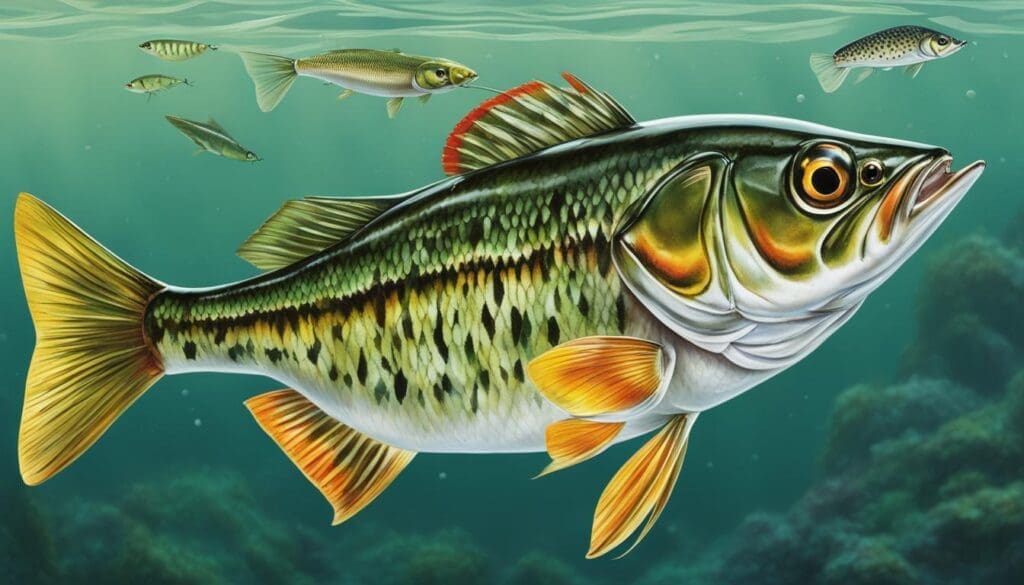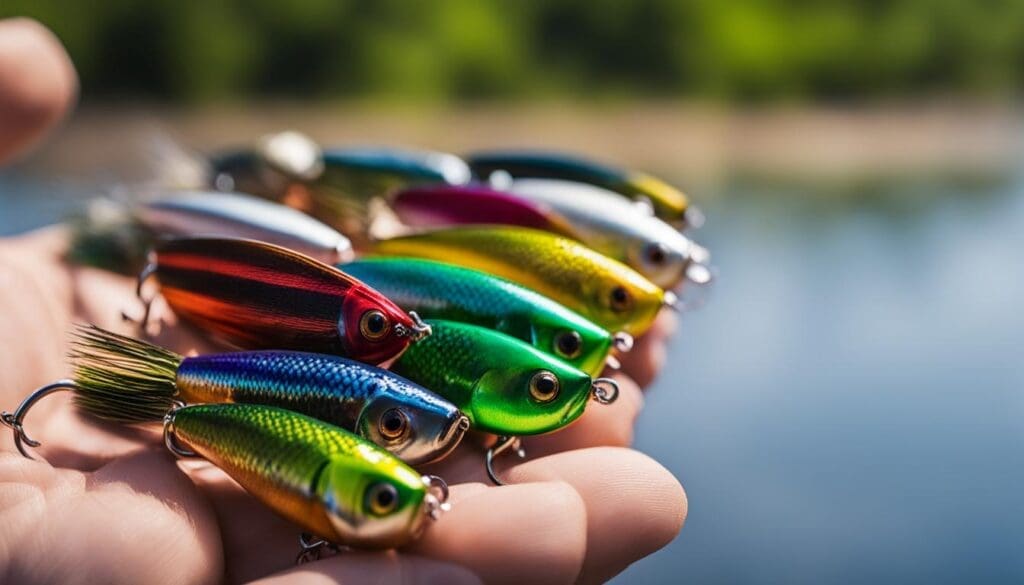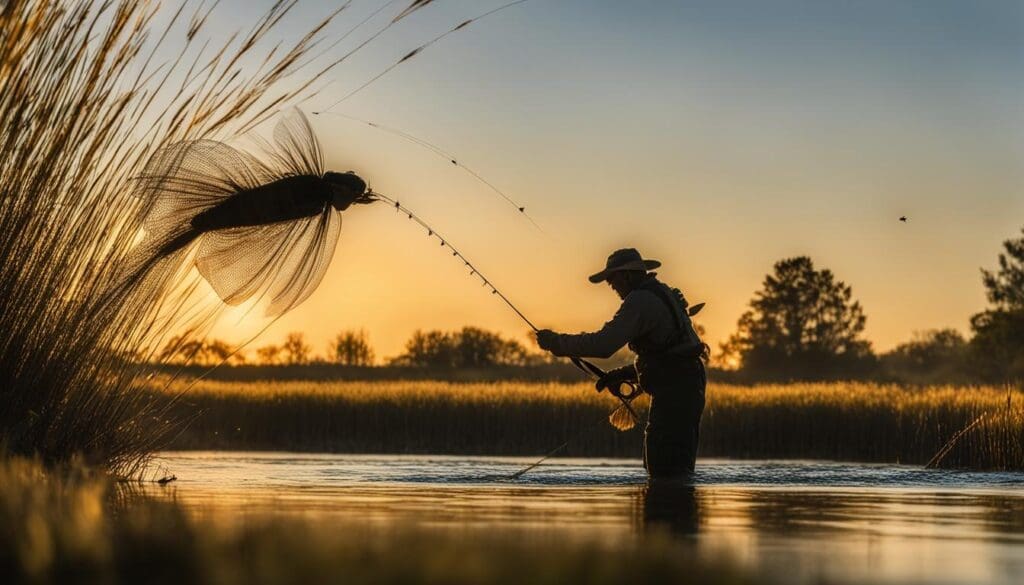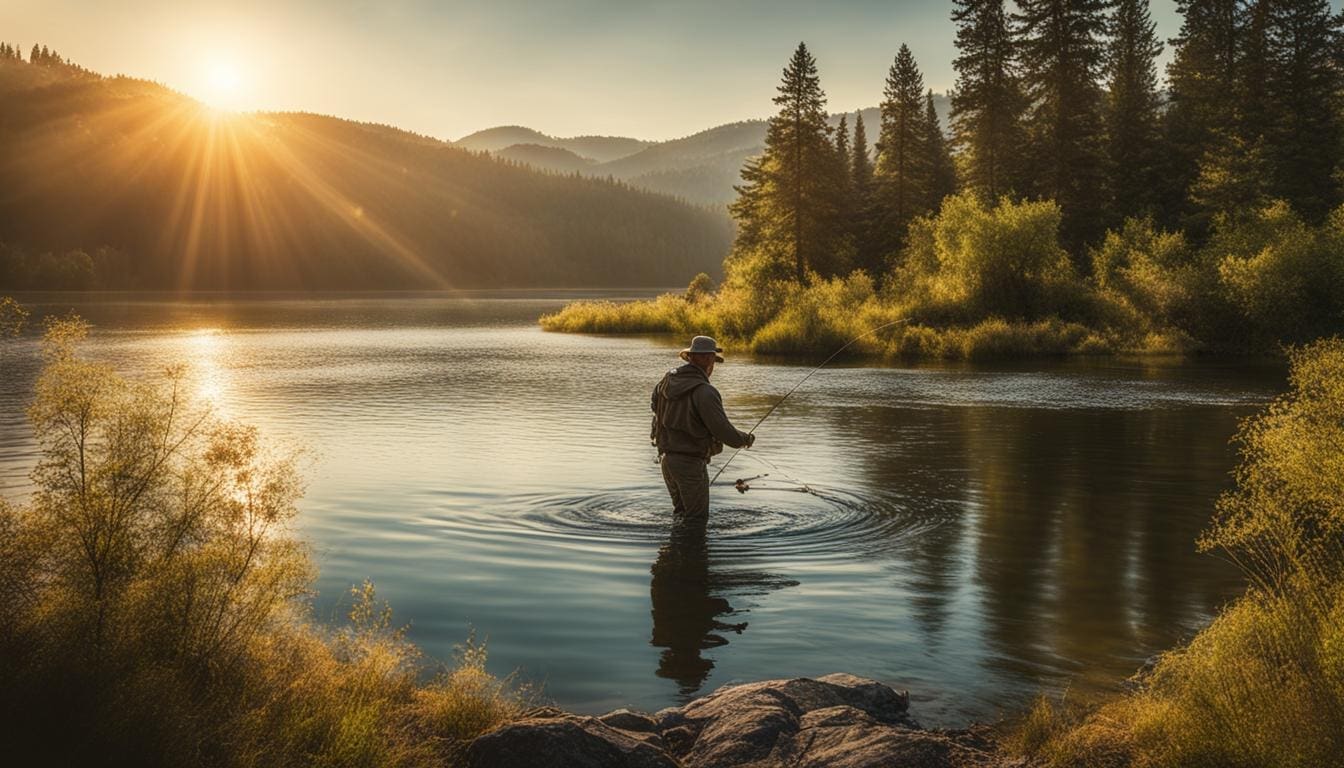For anglers aiming to elevate their game, the concept of “match the hatch with baits” is a cornerstone of successful angling. This strategic approach taps into the predatory instincts of bass by emphasizing the selection of lures that replicate the natural prey encountered in their environments. Precision in matching hatch in fishing, focusing on size, color, and behavioral patterns, is essential to lure the sought-after catch. Implementing fishing tactics for matching hatch requires a blend of keen observation and an understanding of the ecosystem to achieve natural prey imitation. Here’s how to engage in this effective angling method.
Key Takeaways
- Understand local forage species to match the hatch with baits effectively.
- Observe prey characteristics like size, color, and movement for accurate natural prey imitation.
- Adjust baits seasonally and locally to align with bass feeding habits.
- Utilize both visual and behavioral bait cues to mimic natural forage successfully.
- Combine observation with fishing tactics for matching hatch for a more productive angling experience.
Understanding the Concept of Matching the Hatch
At the heart of successful angling lies a technique widely revered for its effectiveness — matching the hatch. This strategy is not just about the mere bait choice to match hatch; it’s an embodiment of acute awareness and the art of deception in the aquatic realm. As anglers, the golden rule we abide by is to present an artificial bait that is a near-perfect replica — in form, hue, and behavior — of the natural prey bass voraciously feed on.
Adapting to the seasonal and local banquet set forth by nature, we employ bait adaptation to hatch techniques, becoming the ultimate puppeteers of the underwater theater. To master this art, one must delve deep into the ecology of the fishing grounds, noting the intricate details of the prevalent prey. Whether it be the iridescence of a shad, the mottled carapace of a crayfish, or the fragile drift of a newly hatched mayfly — these are the blueprints we must follow.
| Prey Type | Identifying Characteristics | Effective Bait Adaptation |
|---|---|---|
| Crayfish | Red, browns, greens; common in rocky or vegetated areas | Crankbaits and skirted jigs mimicking aforementioned colors and hard shells |
| Shad | Silvery, travels in schools, size variation | Shad pattern minnow baits, soft plastic jerkbaits for matching size and movement |
| Mayflies | Small winged insects, spectacular hatches clutter waters | Rapid retrieval lures to provoke reaction strikes during hatches |
Understanding and applying angling strategies for hatch periods can mean the difference between an uneventful day and an exhilarating experience that celebrates the raw connection between angler and fish. Thus, as we venture into the serenade of casts and retrieves, we do so equipped with the knowledge to match, and perhaps outwit, the natural banquet below the ripples — a true test of our finesse in matching natural insect hatches and beyond.
Identifying Key Prey Species for Bass
To outsmart a bass, you must first understand its diet. Anglers who can mimic natural prey effectively increase their chances of a successful catch. In the world of bass angling, knowing which lure choices for hatch periods to use is tantamount to speaking the language of the fish. Let’s explore some of the most commonly feasted-on species that should shape your bait selection.
Crayfish: The Freshwater Crustacean Favorite
Found in nearly every U.S. waterbody with rocky or veggie-rich content, crayfish are like the steak dinner for bass. When it comes to fishing with hatch matching, crayfish imitators are a top choice. Itemizing them in your tackle box in shades of reds, browns, and greens can be the difference between a mediocre and a magnificent day on the water.
Bluegills: The Ubiquitous Panfish Prey
Bluegills, those sun-drenched, shoreline-hugging delights, are a persistent menu item for bass. Skilled anglers pay homage to these disc-shaped delicacies with lure choices for hatch periods using bluegill pattern square bills and swim-jigs that turn the tables, making the predator the prey.
Shad: The Essential Baitfish in Reservoirs and Rivers
Shad, the silvery flash in the pelagic waters of rivers and reservoirs, represents a primary food source that sets bass on a feeding frenzy. Shad pattern lures are irreplaceable in your kit, emulating the real deal with minnow baits and jerkbaits that dazzle and deceive.
| Prey Species | Optimal Habitats | Seasonal Activity | Recommended Lures |
|---|---|---|---|
| Crayfish | Rocky areas, aquatic vegetation | March – May (prespawn period) | Crankbaits, Skirted Jigs |
| Bluegills | Near shorelines, cover heavy areas | After bass spawn (spawning period) | Bluegill pattern square bills, Swim-Jigs |
| Shad | Pelagic zones, schooling in open water | Shad spawn (April – May), Winter season | Shad pattern Minnow Baits, Jerkbaits |
To succeed in fishing with hatch matching, one must not only choose lures that visually mimic natural prey, but also understand the behavioral intricacies of these species. This trifecta of knowledge on crayfish, bluegills, and shad will guide your lure adaptations and refine your strategies, leading to a bountiful bass harvest.
Seasonal Patterns of Prey and How to Adapt
Fishing proficiency requires adapting strategies to match the season’s offerings. As prey species follow their own life cycles, so must anglers adjust their bait selection for hatch to suit these patterns. Recognizing and exploiting bass feeding habits during specific periods is paramount for successful angling.
Spring Time: Spawning and Prey Movement
In the vibrant spring waters, bass exhibit a predilection for protein-rich crayfish, thus making this the optimal moment for utilizing crayfish imitators. Ensuring your fishing during hatch periods aligns with this natural occurrence can significantly improve catch rates.
Summer Period: Matching the Active Forage
Heat-infused summer days steer bluegills to spawning activities, fetching the attention of opportunistic bass. Anglers must then pivot to mimic hatch conditions by brandishing lures that imitate these active forages, primarily around spawning zones.
Fall Transition: Capitalizing on Schooling Behavior
Come autumn, the angling tapestry shifts as bass forage on forming groups of yellow perch and other species. Lure strategies for hatch periods should then steer towards swimbaits and crankbaits, designed to mimic these schooling motifs to attract bass on the prowl.
| Season | Prey Species in Focus | Recommended Lures |
|---|---|---|
| Spring | Crayfish | Crayfish imitators like crankbaits and jigs in red, brown, and green |
| Summer | Bluegills | Bluegill pattern square bills and swim-jigs that replicate sunfish traits |
| Fall | Yellow Perch | Swimbaits and crankbaits that echo the textures and movements of schooling perch |
Mastering bait selection for different hatch periods forms the crux of angling success. By angling to mimic hatch behaviors, with precise lure strategies, the adept fisherman weaves through the ebb and flow of nature’s rhythms, ensuring optimal outcomes assisted by a thorough knowledge of seasonal bait usage.
Match the Hatch with Baits: Imitating Natural Prey
The practice of mimicking the hatch in fishing transcends mere imitation; it demands an angler’s full immersion into the environment of their quarry. Bass, astute and selective in their feeding habits, require more than a visual doppelganger in a bait. They necessitate a facsimile in function, behavior, and habitat mirroring. To meet this challenging spectrum, selecting baits for hatch matching is an exercise in precision and subtlety

Understanding the particulars of local forage species is paramount. One must consider not just the color and size, but also the movement – the cadence of a crayfish’s scamper or the erratic dart of an injured shad. Whether you are utilizing the technological marvels of modern lure design or relying on the tried-and-true classics, each choice must be deliberate, each presentation calculated.
- For an insect hatch, consider floatable, skittering topwaters that replicate the accidental tumble of a mayfly into the water’s embrace.
- When simulating crayfish, incorporate jigs that can adopt the defensive posture and sudden bursts of these crustaceous morsels.
- Shad imitations should encompass not just the silver flash, but the schooling, darting chaos that triggers the predatory chase response in bass.
Every angler dreams of that triumphant moment, the thrilling culmination of a skillful cast with an effective hatch matching bait – a bait so convincing in its deception that it elicits the unreserved commitment of a bass. It’s an artful dance, a confluence of angler knowledge and predator instinct. To match the hatch is to converse with nature, in a tongue spoken through lures and retrieves. It’s here, in this exquisite melding of sport and science, that fishing transcends, becoming something more akin to poetry.
Lure Selection: The Art of Bait Imitation
Perfecting the art of bait imitation is a crucial element in the angler’s toolkit. A discerning eye and the right lure selection for natural hatch can significantly enhance the chances of a fruitful outing. To closely mimic natural prey, one must choose the proper lures that reflect not only the appearance but also the behavior of the bass’s favorite delicacies. Below, we examine the lures that best represent various prey, and how to utilize them to up your angling game.
Crankbaits and Skirted Jigs for Crustaceans
When crustaceans are on the bass menu, crankbaits and skirted jigs are the go-to options for mimicry. These lures should match the natural colors and movements of prey such as crayfish, which are a staple part of the bass diet across many waters. Anglers should look out for structure and vegetation, the crayfish’s natural domains, and cast these lures to stimulate a predatory response.
Swimbaits and Vibrating Jigs for Sunfish
For emulating sunfish, which are ubiquitously hunted by bass, swimbaits and vibrating jigs offer the perfect combination of visual deception and tantalizing action. By utilizing lures in shades of green pumpkin or with bluegill patterns, anglers can effectively entice bass that are targeting these panfish.
Topwater and Jerkbaits for Surface Feeding
Topwater walking baits and jerkbaits shine when it comes to baiting for natural insect hatches and reproducing the erratic movements of surface prey. The splashes and jerks of these lures can mimic the unpredictable nature of insects like mayflies, enticing bass to strike with gusto.
- Select lures that reflect both the color and size of the natural forage to enhance mimicry.
- Employ crankbaits and skirted jigs over rocky and vegetated areas for crustacean imitation.
- Opt for swimbaits and vibrating jigs in green pumpkin and bluegill patterns to simulate sunfish.
- Use topwater and jerkbaits to imitate the surface chaos during insect hatches, provoking excitement and strikes from surface-feeding bass.
In the science of lure selection, there is much to contemplate. A successful angler is a skilled artisan, proficient in the craft of bait imitation, deftly producing lifelike renditions of natural prey. Adept in mimicking natural prey, the angler can manipulate the underwater realm, making a day of fishing not just a pursuit but an artistic expression of baiting strategy.
Colors and Patterns: A Critical Factor in Bait Selection
When refining your bait choice to match hatch, the deliberate use of colors and patterns becomes an angling strategy that should not be overlooked. The hues and designs of your bait can make a profound impact on the willingness of bass to strike. In clear water conditions, where visibility is high, mimicking the local forage with accurate colors is integral. This accuracy in imitation plays into the visual predatory triggers of bass, enhancing the effectiveness of each cast.
Using Natural Colors to Mimic Prey
Success in angling often comes down to the authenticity of your lure. Bass are adept at spotting irregularities in their environment, which is why employing natural colors in your lure selection is so pivotal. These colors are not arbitrarily chosen—they are a reflection of the prevalent forage in the habitat. For the discerning angler, understanding the nuances of natural prey allows for a more accurate representation and, as a result, a more productive fishing experience.
Unconventional Colors for Triggering Strikes
However, there are scenarios where sticking solely to natural patterns may not yield the desired results. It’s during such times that unconventional lure colors can play an instrumental role. These striking, often contrasting colors serve to stand out amongst the plethora of natural forage, eliciting an aggressive response from bass. Unconventional hues can be particularly beneficial when bass have a wide array of food available and the competition for their attention is fierce.

- Consider using red or orange lures when fishing in muddy waters, where these colors can be more visible to bass.
- Experiment with purple or chartreuse during dawn and dusk, or in overcast conditions, to maximize visibility and curiosity.
- When bass are heavily feeding on particular forage, shift to a contrasting color to provide a shock to their system and stand out.
Employing these strategies, by either aligning with the natural bait fish’s appearance or deliberately breaking the pattern, can lead to a more successful angling journey. Each situation calls for a careful consideration of bait presentation; this attention to detail is often what separates a novice angler from a master. By combining an understanding of when to match the hatch with a willingness to occasionally disrupt the pattern with unconventional lure colors, anglers can adapt to any situation the water presents.
The Role of Forage Size in Matching the Hatch
Key to the nuances of hatch matching techniques is the consideration of forage size. Savvy anglers understand that an artificial lure’s size plays a significant role in convincing bass to strike. This section delves into the intricacies of aligning your bait size with the natural forage and discerning when to shift your approach by upsizing or downsizing lures.
Bait Size Alignment with Natural Prey
An integral part of forage size consideration is ensuring that the lure mirrors the size of the prevalent prey in the ecosystem. When bass are targeting small baitfish such as juvenile shad or bluegills, presenting them with downsized versions of your lures can make a substantial difference. It’s an aspect of hatch matching techniques that can lead to a more convincing presentation and ultimately, a more successful day of angling.
When to Upsize or Downsize Your Lure
There are distinct moments within the forage cycle when upsizing or downsizing lures can be particularly effective. Larger prey items, such as adult bluegills or invasive gobies, often trigger the interest of the more competitive and larger bass within a given water system. During such times, upsizing your bait to replicate these larger forage sizes can result in notable catches. Conversely, when the abundant forage is diminutive, downsizing your presentation can yield a surprisingly productive response.
Angling Strategies During Different Hatch Situations
Adapting to the dynamic nature of aquatic environments means understanding and countering the challenges posed by mayfly hatches angling. These events can lead to reduced catch rates as bass gorge on the bountiful mayflies. However, skilled anglers employ specific fishing tactics for matching hatch scenarios, rendering potential setbacks as opportunities for exciting catches.

Navigating Mayfly Hatches and Poor Bite Conditions
Mayfly hatches, though an intriguing spectacle, can signal tough fishing ahead. As bass fill themselves with these easy targets, a traditional approach might not suffice. Observant anglers can, however, convert these poor bite conditions into an action-packed session through strategic adaptation.
Utilizing Speed and Reaction Strikes
One effective method is eliciting reaction strikes. This tactic involves disrupting the bass’s feeding frenzy by presenting lures in a manner that invokes their inherent aggressive instincts. Techniques such as swiftly flipping or pitching, alongside burning a crankbait or spinnerbait across the water, can prompt an instinctual bite. These fast, unpredictable movements can trick a satiated bass into striking out of pure reflex. Here are key methods to incite such reaction strikes during mayfly hatches:
- Flipping and pitching with heavy weights to create a significant disturbance in the water
- High-speed retrieval of crankbaits to simulate fleeing prey
- Using spinnerbaits with vibrant flash to catch the bass’s attention
These techniques require dexterity and persistence, as the timing and speed of each action are crucial for success. By implementing these methods, anglers can rise above challenging hatch conditions, proving that with the right strategy, any situation can become a golden opportunity for a remarkable catch.
Tactical Adaptation to Predators’ Behavior
Effective angling shifts with the changing seasons, bringing about new lure strategies for hatch periods. Delving into an understanding of the aquatic landscape, particularly with bottom dwellers and amphibians, offers an angler a significant edge. Mimicking these prey with strategic bait choices can result in dramatic strikes from bass that are keenly adapted to their environments.
Mimicking Bottom Dwellers and Amphibians
Bottom dwellers, such as gobies, play a crucial role in the diets of predatory fish. To lure these predators, anglers must study the intricacies of these creatures’ movements and accurately mimic them through their bait presentations. Techniques utilizing drop shots and tube jigs are particularly effective in recreating the rapid darting actions associated with gobies feeding off the bottom.
Frog Patterns and Creature Baits in Habitat-Rich Environments
In vegetation-rich waters where frog patterns thrive, lure selection becomes a harmonious dance of imitation and subtlety. Frog pattern lures and soft plastic buzz toads are not merely baits but extensions of the angler’s intent to infiltrate and attract bass hunting in these habitat-centric zones. Employing a thoughtful creature baits strategy here delivers alluring presentations that exploit the feeding habits of bass, paving the way for rewarding fishing experiences.
- Use realistic frog pattern lures that navigate seamlessly over pads and marshy zones.
- Select creature baits that disturb the water in a manner consistent with naturally active amphibians.
- Focus on presentation and retrieval techniques that enhance the allure of each bait type, catering specifically to habitat-rich environments.
Anglers must constantly refine their approach, taking cues from the rhythms of the natural world. By adopting these tactical adaptations to predators’ behavior, the pursuit of matching the hatch evolves into an engaging dialogue between fish and fisherman, one led by strategy, persistence, and an innate understanding of the aquatic realm.
Conclusion: The Proficient Art of Matching the Hatch
In the intricate dance of successful angling, the ability to match the hatch with baits stands paramount, a harmonious blend of science and art. It is the angler’s profound understanding of this concept that elevates the fishing experience from mere chance to a calculated pursuit. Through meticulous observation and the delicate art of bait adaptation, we mimic the natural prey inhabiting the watery theater below us. Whether it’s the crisp flicker of a minnow or the deceptive crawl of a crayfish, mastering the selection of lifelike lures is not merely a skill but an angling philosophy.
Enthusiasts who dedicate themselves to learning and adapting lure selection to the dynamic ecosystems they fish in, find themselves more frequently rewarded with the resounding bend of a rod. Bait adaptation, an action grounded in precision, decoys the keen senses of the bass, invoking upon ourselves a satisfaction matched only by the thrill of the catch. This tactic of natural prey imitation, ingrained within the scrolls of the fishing annals, transcends beyond the ordinary — it is a craft that respects and mirrors the pulse of aquatic life.
The art of lure selection for successful angling demands more than a superficial replica; it requests a lure that epitomizes the very essence of the prey: its silhouette against the light, its rhythm in the water, its fleeting shadow in the depths. Natural prey imitation is a journey, one that sees the angler evolve into an artisan of the underwater world, constructing each scenario with baits that breathe authenticity. Indeed, when an angler becomes adept in the match-the-hatch with baits philosophy, each trip to the water’s edge is not just a promise of productivity but an assurance of an angling narrative rich with intent and fulfillment.
FAQ
What does “matching the hatch” mean in fishing?
In fishing, “matching the hatch” refers to the technique of selecting a bait or lure that closely resembles the natural prey that fish are actively feeding on during a certain period. This can include mimicking the size, color, behavior, and profile of forage species such as insects, crustaceans, or baitfish to increase the likelihood of a strike.
How do I choose the right bait to match the hatch?
Choosing the right bait involves understanding what the local fish are eating. Observe the environment to identify key prey species such as crayfish, bluegills, or shad, and then select lures that replicate those species in terms of appearance and movement. Factors such as color, size, and action should align with the natural prey to effectively match the hatch.
Why is lure color important when matching the hatch?
Lure color is crucial when matching the hatch as it helps your lure resemble the natural prey. In clear water, where fish can see well, natural colors can be more effective, while in murky water or when fish are aggressive, more unconventional colors may help your bait stand out and trigger bites.
Should I always match the exact size of the natural prey?
While matching the exact size of the natural prey can be effective, sometimes downsizing or upsizing your lure can yield better results. Downsizing may work if the fish are feeding on smaller forage, or when fishing pressure is high. Upsizing can attract larger predatory fish looking for a substantial meal, especially if larger forage species are present.
What are some effective baits for matching crayfish, bluegills, and shad?
For crayfish, try using crayfish imitators like skirted jigs or crankbaits in natural crayfish colors. For bluegills, choose swimbaits or vibrating jigs that mimic sunfish. When imitating shad, opt for shad pattern minnow baits, crankbaits, or soft plastic jerkbaits.
How do seasonal patterns affect my bait selection to match the hatch?
Seasonal patterns play a significant role in determining which prey species are most active and, consequently, what the fish are feeding on. In the spring, focus on baits that mimic spawning creatures like crayfish. Summertime requires lures that replicate the movements and colors of active forage like bluegills. During the fall, as fish prepare for winter, they often target schooling baitfish such as perch, calling for swimbaits and crankbaits that imitate these species.
Can I still match the hatch if fish are feeding on surface insects like mayflies?
Yes, during insect hatches such as mayflies, you can use topwater lures, walking baits, or jerkbaits designed to mimic the behavior and appearance of these insects. Such lures should be presented with a technique that replicates the natural movements of the hatching insects on the water’s surface.
When should I consider using unconventional lure colors?
Unconventional lure colors can be used to your advantage when fish are accustomed to seeing typical natural colors, or when you’re trying to elicit a reaction strike from an aggressive fish. Bright, contrasting, or flashy colors can provoke curiosity or territorial behavior, leading to bites.
What strategies should I use when fishing during mayfly hatches?
During mayfly hatches, when the normal bite may be difficult, employ aggressive retrieval speeds or vary your techniques to prompt reaction strikes from bass that are focused on the abundant food source. Quick retrieves, erratic movements, and lures that can create commotion can entice bass to strike, even when they are not actively searching for additional food.
How do I adapt my fishing tactics for bottom-dwelling prey like gobies?
To mimic bottom-dwelling prey such as gobies, utilize lures and techniques that keep your presentation near the bottom. Baits like drop shots, tube jigs, or creature baits with darting or scurrying actions can accurately recreate the movements of these types of prey, appealing to predatory fish that feed off the bottom.

